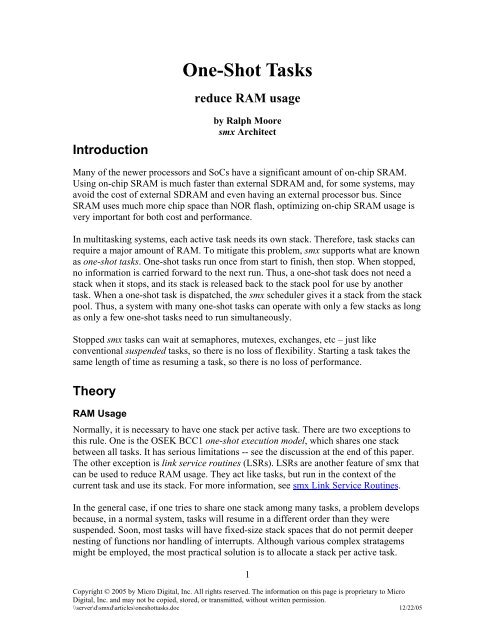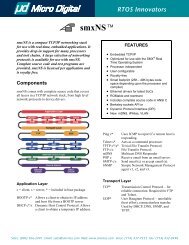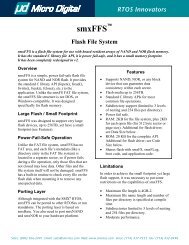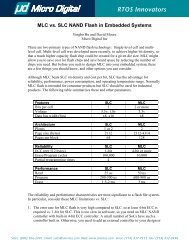One-Shot Tasks - RTOS
One-Shot Tasks - RTOS
One-Shot Tasks - RTOS
Create successful ePaper yourself
Turn your PDF publications into a flip-book with our unique Google optimized e-Paper software.
<strong>One</strong>-<strong>Shot</strong> <strong>Tasks</strong><br />
reduce RAM usage<br />
Introduction<br />
by Ralph Moore<br />
smx Architect<br />
Many of the newer processors and SoCs have a significant amount of on-chip SRAM.<br />
Using on-chip SRAM is much faster than external SDRAM and, for some systems, may<br />
avoid the cost of external SDRAM and even having an external processor bus. Since<br />
SRAM uses much more chip space than NOR flash, optimizing on-chip SRAM usage is<br />
very important for both cost and performance.<br />
In multitasking systems, each active task needs its own stack. Therefore, task stacks can<br />
require a major amount of RAM. To mitigate this problem, smx supports what are known<br />
as one-shot tasks. <strong>One</strong>-shot tasks run once from start to finish, then stop. When stopped,<br />
no information is carried forward to the next run. Thus, a one-shot task does not need a<br />
stack when it stops, and its stack is released back to the stack pool for use by another<br />
task. When a one-shot task is dispatched, the smx scheduler gives it a stack from the stack<br />
pool. Thus, a system with many one-shot tasks can operate with only a few stacks as long<br />
as only a few one-shot tasks need to run simultaneously.<br />
Stopped smx tasks can wait at semaphores, mutexes, exchanges, etc – just like<br />
conventional suspended tasks, so there is no loss of flexibility. Starting a task takes the<br />
same length of time as resuming a task, so there is no loss of performance.<br />
Theory<br />
RAM Usage<br />
Normally, it is necessary to have one stack per active task. There are two exceptions to<br />
this rule. <strong>One</strong> is the OSEK BCC1 one-shot execution model, which shares one stack<br />
between all tasks. It has serious limitations -- see the discussion at the end of this paper.<br />
The other exception is link service routines (LSRs). LSRs are another feature of smx that<br />
can be used to reduce RAM usage. They act like tasks, but run in the context of the<br />
current task and use its stack. For more information, see smx Link Service Routines.<br />
In the general case, if one tries to share one stack among many tasks, a problem develops<br />
because, in a normal system, tasks will resume in a different order than they were<br />
suspended. Soon, most tasks will have fixed-size stack spaces that do not permit deeper<br />
nesting of functions nor handling of interrupts. Although various complex stratagems<br />
might be employed, the most practical solution is to allocate a stack per active task.<br />
1<br />
Copyright © 2005 by Micro Digital, Inc. All rights reserved. The information on this page is proprietary to Micro<br />
Digital, Inc. and may not be copied, stored, or transmitted, without written permission.<br />
\\server\d\smxd\articles\oneshottasks.doc 12/22/05
This being the case, how large must task stacks be? Unfortunately, even a lean kernel is<br />
likely to impose the need for about 200 bytes of stack. Added to this are the requirements<br />
of the tasks, themselves, including maximum function nesting and space for<br />
autovariables, which can easily add another 200-400 bytes. Some standard C library<br />
functions (e.g. sprintf( )) can add much more than this, just by themselves. This number<br />
does not even include saving a coprocessor state or making room for floating point<br />
emulation.<br />
Finally, space is needed for the maximum possible nesting of interrupts — another 200<br />
bytes, or so. It is true that interrupt service routines could have their own stacks.<br />
However, that adds delay at the most critical point of most embedded systems — namely,<br />
at the point of interrupt processing. Hence, although done in non-real time operating<br />
systems (e.g. MS-DOS) interrupt stacks are not a good idea for high-performance,<br />
embedded systems. Interrupt stacks also create other complexities and may not even save<br />
much memory.<br />
Hence, we end up with 600 to 800 bytes. Stacks can easily go to 1000 bytes or more<br />
when a file system or networking is added. Thus, an embedded system with 20 tasks is<br />
likely to require about 20 KB of RAM.<br />
Fine-Grained vs. Coarse-Grained Task Structure<br />
Because of the significant memory required per stack, the tendency on the part of many<br />
programmers is to minimize the number of tasks. This has the unfortunate consequence<br />
of making each task more complex than is necessary. Large tasks defeat the purpose of a<br />
multitasking kernel, which is to simplify the programming job by dividing the application<br />
into simple tasks. Simple tasks achieve complex results via their interactions. Indeed,<br />
creating a few large, complex tasks is akin to creating processes in big multi-user<br />
systems, such as UNIX. This is not the correct way to use a high-performance,<br />
multitasking kernel.<br />
An example will clarify this. Suppose we are developing a communication system.<br />
Usually it works well to have at least two tasks — a receive task and a send task. Suppose<br />
there are 10 identical channels. How many tasks should there be? I suggest 20, but many<br />
designers would struggle with only two. Why are 20 better? Because:<br />
(1) The code is simpler — it only has to deal with one channel. Exactly the same<br />
receive code is used by all 10 receive tasks. Similarly for the send code. Thus to<br />
have 20 tasks does not add any more code than having two. In fact, the amount of<br />
code required may be much less, because it is simpler.<br />
(2) More of what needs to be done is being done by proven kernel code. For example,<br />
proven kernel objects, such as semaphores and messages, are likely to be used<br />
more and untested application mechanisms, such as flags and buffers, are likely to<br />
be used less. Kernel code is orders of magnitude more reliable than brand-new<br />
application code.<br />
2<br />
Copyright © 2005 by Micro Digital, Inc. All rights reserved. The information on this page is proprietary to Micro<br />
Digital, Inc. and may not be copied, stored, or transmitted, without written permission.<br />
\\server\d\smxd\articles\oneshottasks.doc 12/22/05
(3) It is scalable — channels can be added or removed merely by creating or deleting<br />
tasks. Code need not be changed at all.<br />
(4) It is dynamic — tasks can be created and deleted on the fly.<br />
(5) The final design is easier to understand and to maintain by different programmers<br />
than the originators.<br />
(6) Interfaces between sections of code are defined by the kernel API. Hence, they<br />
are more robust and better documented.<br />
(7) The kernel adds extensive error checking and error reporting. These seldom get<br />
put into application code, yet they speed debugging.<br />
So, in this simple example, there are abundant reasons to support a fine-grained task<br />
structure. When dealing with the needs of high-performance, high-reliability embedded<br />
systems, some rethinking of basic concepts is appropriate. First, we need a kernel (not an<br />
os) that is mean and lean. Then we need to learn how to best utilize that kernel to achieve<br />
the project goals. <strong>One</strong>-shot tasks are a step in that direction.<br />
<strong>One</strong>-<strong>Shot</strong> Task Operation<br />
So, let’s get back to the subject of stacks. Wouldn’t it be nice if at least some tasks could<br />
share stacks? Then there would not be so many stacks. This is where we introduce the<br />
concept of the unbound stack. What is an unbound stack? An unbound stack is a stack,<br />
which is not permanently bound to any particular task — i.e. it can be shared. How is this<br />
possible? It works as follows: Unbound stacks are all the same size and belong to a single<br />
stack pool. When a one-shot task is first dispatched (i.e. started running), unless it already<br />
has a permanently bound stack, it is loaned a stack from the stack pool. As long as the<br />
task is active (i.e. either running or suspended), it keeps the stack. Hence, the task and<br />
stack function normally when the task is active. However, when the one-shot task<br />
completes its function and is ready to wait for more work, it gives up the stack. We call<br />
this stopping the task as opposed to suspending it. In the latter case, the task would keep<br />
the stack, but in the former case, the task has no need for the stack so the task gives it up.<br />
(In this regard, it is important to know that a one-shot task is later restarted from the<br />
beginning rather than being resumed from where it left off.)<br />
The stack goes back to the stack pool where it is available to be used by another task.<br />
Now the one-shot task is in what we call the unbound mode:<br />
3<br />
Copyright © 2005 by Micro Digital, Inc. All rights reserved. The information on this page is proprietary to Micro<br />
Digital, Inc. and may not be copied, stored, or transmitted, without written permission.<br />
\\server\d\smxd\articles\oneshottasks.doc 12/22/05
Figure 1: Task Modes<br />
In this mode, the task has no state variables (e.g. register contents) and no auto variables<br />
worth remembering. This state is appropriate only if the task has completed all of its<br />
work and is ready to start over again, or to restart, as we call it. This necessitates a<br />
different code structure as shown in Figure 2.<br />
Code Examples<br />
a. Conventional Task:<br />
void atask_main (void)<br />
{<br />
MCB_PTR msg:<br />
// initialize<br />
unlock (self);<br />
while (msg = receive (xchg, INF))<br />
{<br />
// process msg<br />
}<br />
}<br />
b. <strong>One</strong>-shot Task:<br />
void otask_main_init (void)<br />
{<br />
// initialize<br />
// change task main function:<br />
task.fun = otask_main;<br />
receive_stop (xchg, INF);<br />
}<br />
void otask_main (MCB_PTR msg)<br />
{<br />
// unlock (self);<br />
// process msg<br />
receive_stop (xchg, INF);<br />
}<br />
Figure 2: Code for Convention and <strong>One</strong>-<strong>Shot</strong> <strong>Tasks</strong><br />
The conventional task is created with atask_main( ) as its main function:<br />
TCP_PTR atask;<br />
atask = create_task(atask_main, NORM, 1000);<br />
start(atask);<br />
atask has normal priority and a permanently bound stack of 1000 bytes. When atask first<br />
starts, it initializes and unlocks itself (so it can be preempted by higher priority tasks),<br />
then goes into an infinite while loop. At the start of this loop, the task waits at xchg for a<br />
message. When a message is received, it is processed, then the task waits at xchg for<br />
another message. This process repeats for every new message received. In this particular<br />
example, atask never exits the while loop unless it is externally stopped or deleted.<br />
4<br />
Copyright © 2005 by Micro Digital, Inc. All rights reserved. The information on this page is proprietary to Micro<br />
Digital, Inc. and may not be copied, stored, or transmitted, without written permission.<br />
\\server\d\smxd\articles\oneshottasks.doc 12/22/05
The one-shot task has a different structure. It is created with otask_main_init( ) as its<br />
initial main function:<br />
TCP_PTR otask;<br />
otask = create_task(otask_main_init, NORM, 0);<br />
start(otask);<br />
otask has normal priority and no permanently bound stack. When otask first runs,<br />
otask_main_init( ) does the initialization, then otask’s main function is changed to<br />
otask_main( ) and otask stops on xchg. When a message is received, otask restarts, except<br />
this time with otask_main( ) as its main function. Note that the message handle, msg, is<br />
passed in as a parameter, not as a return value, as it is for atask. This is because, no code<br />
executes after a stop function (i.e. receive_stop().) smx handles passing in the msg<br />
parameter from receive_stop(). otask may or may not unlock itself (see discussion<br />
below). The message is processed and otask again stops on xchg. otask_main( ) runs,<br />
from the start, each time a new message is received.<br />
Note that the results produced by atask and otask are the same, but their mechanisms are<br />
much different.<br />
More Considerations<br />
In the above discussion, it was noted that otask may or may not unlock itself. This is<br />
because, if otask is very short, it is probably desirable to leave it locked in order to<br />
prevent excessive task switching. This is because a locked task cannot be preempted by<br />
any other task (but ISRs and LSRs can run.) Such a task is called a non-preemptible oneshot<br />
task. The reason that smx tasks start locked and must be deliberately unlocked, is to<br />
assure that they cannot be preempted once they start running.<br />
It is not a requirement that one-shot tasks be locked. They can be unlocked. However,<br />
then they can be preempted and will thus hold borrowed stacks longer. This is not a<br />
problem, but a bigger stack pool may be required. Ideally, a one-shot task is a tiger task,<br />
like an interrupt service routine. It is best to let it rip.<br />
<strong>One</strong>-shot tasks can loop, if necessary, such as to process a series of packets. <strong>One</strong>-shot<br />
tasks can also suspend themselves, such as to receive a packet, then process it. Hence, a<br />
one shot task can act like a conventional task to process a burst of activity. However,<br />
once it finishes its business, it stops and must be restarted to run again. When restarted, it<br />
always runs from the beginning of its main code. (This is why first-time initialization<br />
code must be put into a separate function that is run only once.)<br />
Stack RAM can also be saved by deleting tasks, when no longer needed and recreating<br />
them when needed. However, this adds overhead whereas stopping and starting tasks<br />
adds no overhead versus suspending and resuming them (except that a task may have to<br />
wait for a stack). Also, a deleted task cannot wait for an event. In addition, it loses its<br />
TCB and handle and thus can no longer be tracked by smxAware nor a debugger.<br />
5<br />
Copyright © 2005 by Micro Digital, Inc. All rights reserved. The information on this page is proprietary to Micro<br />
Digital, Inc. and may not be copied, stored, or transmitted, without written permission.<br />
\\server\d\smxd\articles\oneshottasks.doc 12/22/05
Advantages of <strong>One</strong> <strong>Shot</strong> <strong>Tasks</strong><br />
What is the advantage of otask? Let’s return to our example and look at the 10 send tasks.<br />
Suppose outgoing traffic is very light and a send task spends 90% of its time waiting at<br />
an exchange for another message to send. Why tie up a valuable stack all this time? Quite<br />
possibly, 2 stacks (or even 1 stack) would satisfy the needs of the 10 tasks. Hence, using<br />
one-shot tasks would, in this one area, give an 80% reduction in stack space!<br />
Three advantages are gained: (1) potential cost reduction due to eliminating external<br />
RAM; (2) potential increase in performance due to using on-chip SRAM; (3) freedom to<br />
utilize a fine-grained task structure to achieve the optimum architecture for the<br />
application at hand. With reference to (2), note that putting stacks into on-chip SRAM<br />
has particularly great impact upon improving performance. This is especially true for<br />
multitasking systems because there is a strong tendency to use autovariables, which are<br />
stored in task stacks, in order to achieve subroutine reentrancy.<br />
What about disadvantages: (1) performance? It turns out that getting and binding a free<br />
stack is an efficient process. It costs no more time than restoring registers from a bound<br />
stack. Hence, there is no performance hit for using one-shot tasks. (2) reduced flexibility?<br />
smx permits a one-shot task to wait, in the stopped condition or in the suspended<br />
condition, at all of the same objects (e.g. semaphores, exchanges, etc) as a conventional<br />
task. Hence, a one-shot task can do everything a conventional task can do. (3) run out of<br />
stacks? If no stack is available, smx stops the task being started, for a tick, then tries to<br />
dispatch it again. In such a situation, processing is probably stacked up due to limited<br />
processor bandwidth, anyway; so waiting for free-stacks does not degrade overall<br />
performance. At worst, a high-priority, one-shot task could miss a deadline. If this causes<br />
a problem, such a task can be given a permanently bound stack to avoid the problem.<br />
<strong>One</strong>-shot tasks are good for operations that are simple, infrequent, largely mutually<br />
exclusive (or can wait a tick or two for stacks), and finish in one pass. Although they are<br />
not a panacea for all embedded systems, they are good tools to have in your toolbox.<br />
<strong>One</strong>-shot tasks have been an integral part of smx from the start and many applications<br />
have benefited from them.<br />
smx vs. OSEK Stack Sharing<br />
The smx one-shot task stack-sharing feature is similar to the OSEK BCC1 one-shot<br />
execution model. The latter allows sharing a single stack among all tasks. The required<br />
stack space is determined by the sum of the maximum stack sizes of all priority levels.<br />
For example, if there were two priority 3 tasks requiring stacks of 200 and 300 bytes,<br />
then 300 would be added for level 3. This model requires that every task run to<br />
completion, except while preempted by a higher priority task.<br />
The smx approach requires a bit more stack space but it is less restrictive. Also, it is<br />
easier and less error-prone to calculate the stack space required. Under smx, stacks may<br />
be either retained or surrendered when waiting for messages, signals, events, timeouts,<br />
6<br />
Copyright © 2005 by Micro Digital, Inc. All rights reserved. The information on this page is proprietary to Micro<br />
Digital, Inc. and may not be copied, stored, or transmitted, without written permission.<br />
\\server\d\smxd\articles\oneshottasks.doc 12/22/05
etc by using either the suspend or stop version of the smx call. Hence, stopping vs.<br />
suspending a task introduces no constraints on what the task can do. Also, when a task<br />
that surrendered its stack is restarted, it is given a new stack from the stack pool, and the<br />
task starts from the beginning of its code. (Hence, information from the old stack is not<br />
needed.) There is no performance penalty for starting a task with a new stack vs.<br />
resuming a task that already has a stack.<br />
In contrast to OSEK BCC1, smx allows a mixture of conventional tasks, with permanent<br />
stacks, and one-shot tasks, with temporary stacks. If we make the rule, like OSEK BCC1,<br />
that one-shot tasks may not suspend themselves, then the number of stacks required in the<br />
stack pool is equal to the number of different priorities of one-shot tasks. For example, if<br />
there are 10 one-shot tasks having 3 different priorities, then only 3 stacks are required in<br />
the stack pool. Unlike OSEK, these stacks must all be the same size.<br />
Note that one-shot smx tasks can wait at semaphores, exchanges, and other smx objects,<br />
when stopped. OSEK one-shot tasks cannot do this. Also, to add conventional tasks,<br />
OSEK requires changing to the ECC1 or ECC2 model, neither of which permits stack<br />
sharing. Hence, it is all or nothing with OSEK. With smx no such limitation exists -- there<br />
can be any number of either kinds of task. Not only that, one-shot tasks can behave like<br />
conventional tasks until they stop. Because of these differences, smx gives a programmer<br />
much greater flexibility in fitting an application into limited RAM space, than does<br />
OSEK.<br />
For more information:<br />
1. smx User’s Guide – See Chapter 16, More on <strong>Tasks</strong>.<br />
2. smx Reference Manual – See stop versions of smx services.<br />
7<br />
Copyright © 2005 by Micro Digital, Inc. All rights reserved. The information on this page is proprietary to Micro<br />
Digital, Inc. and may not be copied, stored, or transmitted, without written permission.<br />
\\server\d\smxd\articles\oneshottasks.doc 12/22/05








